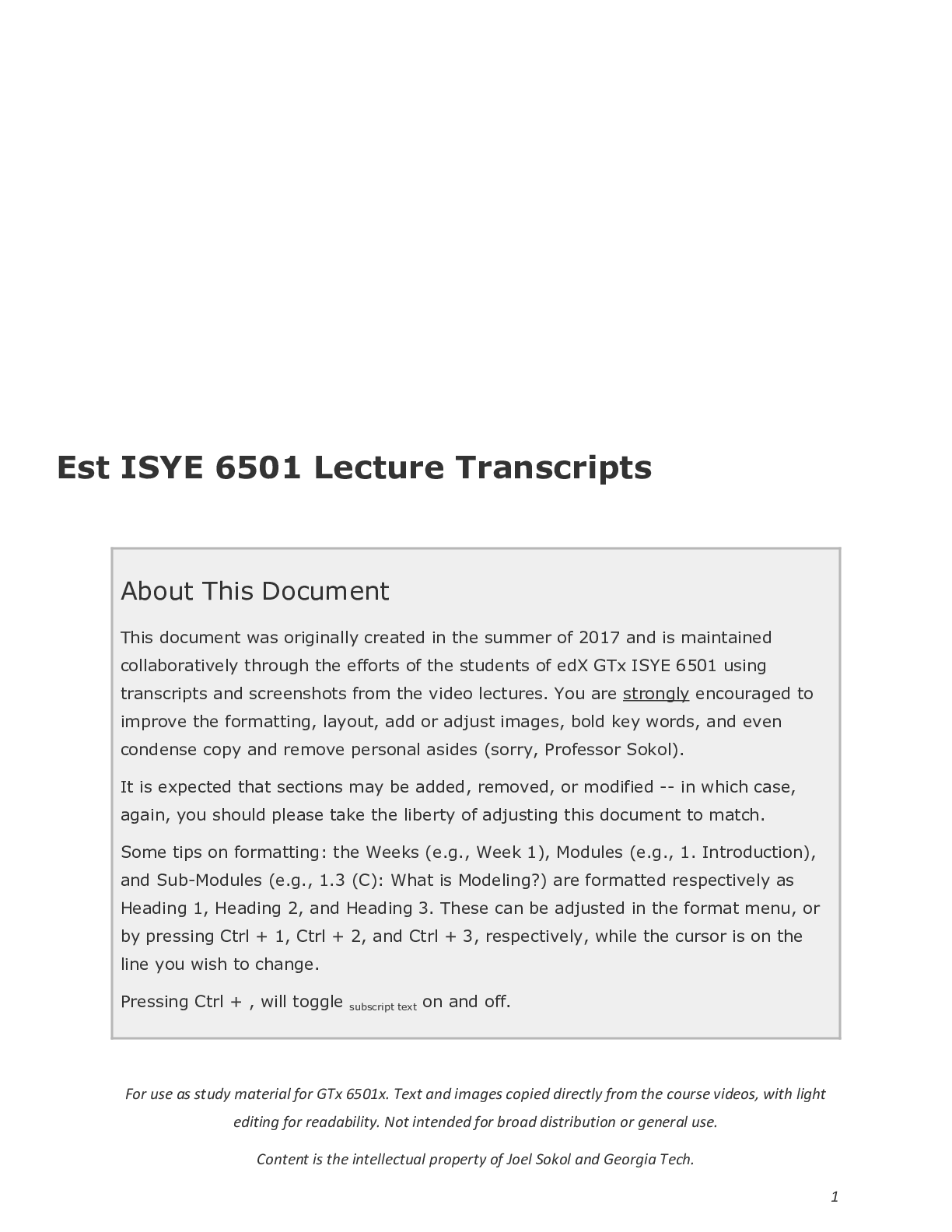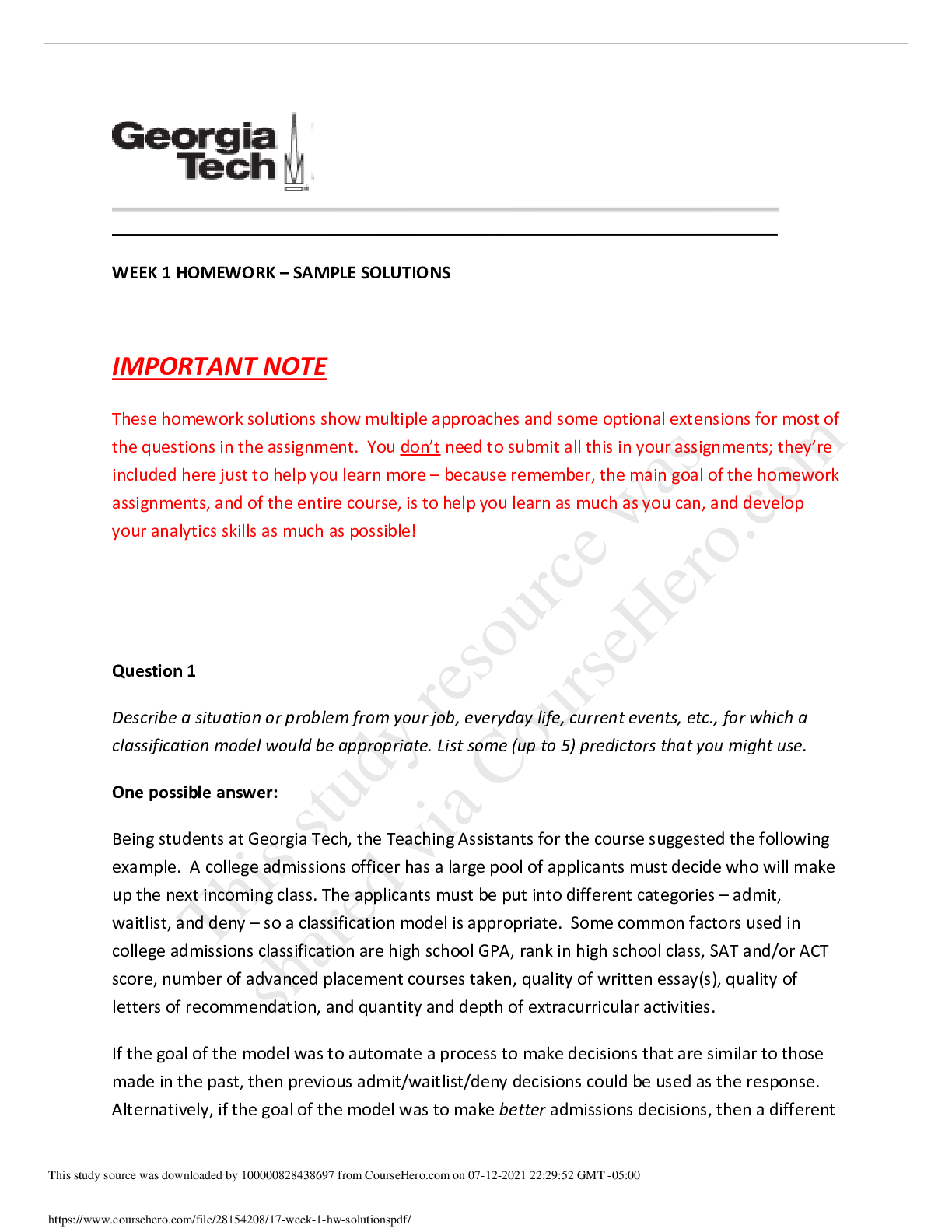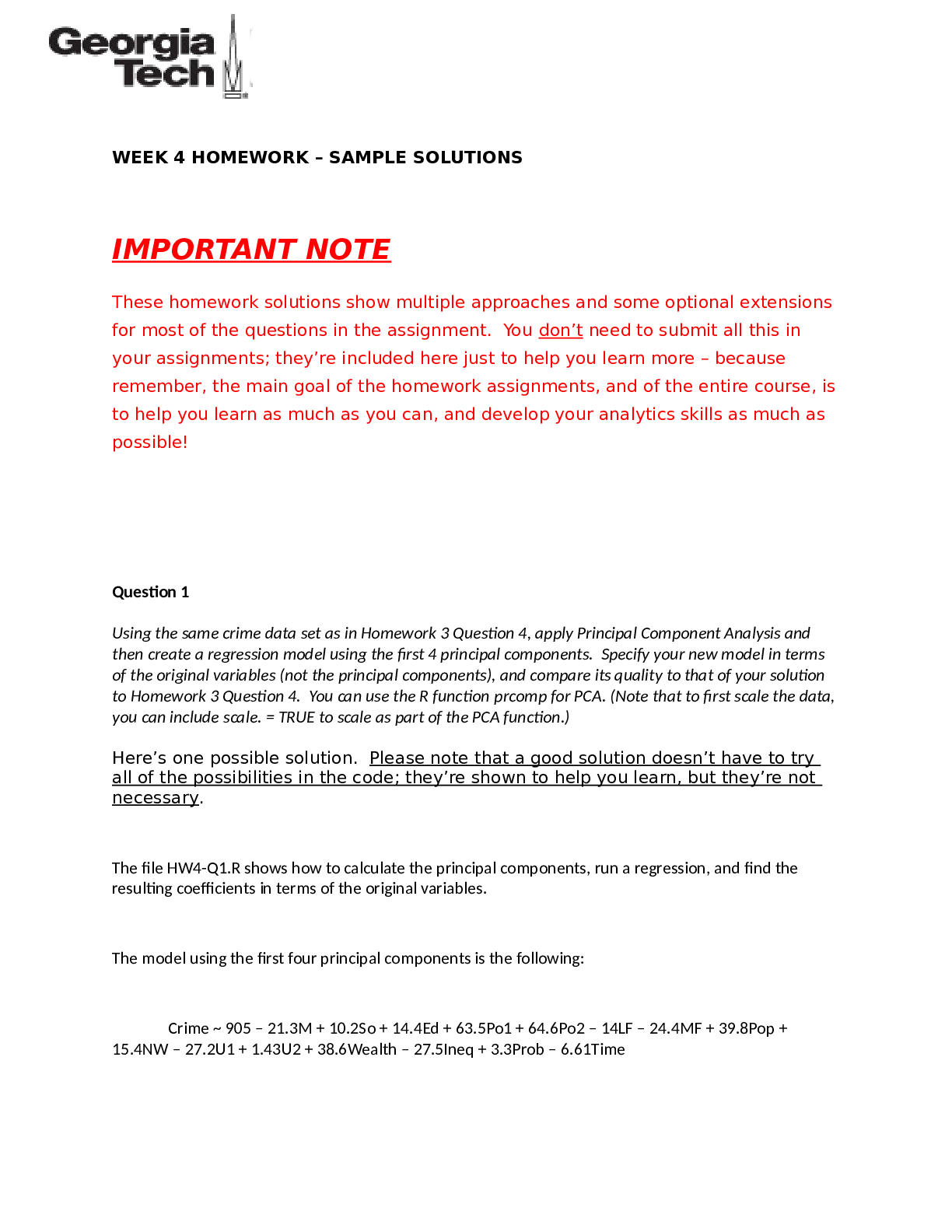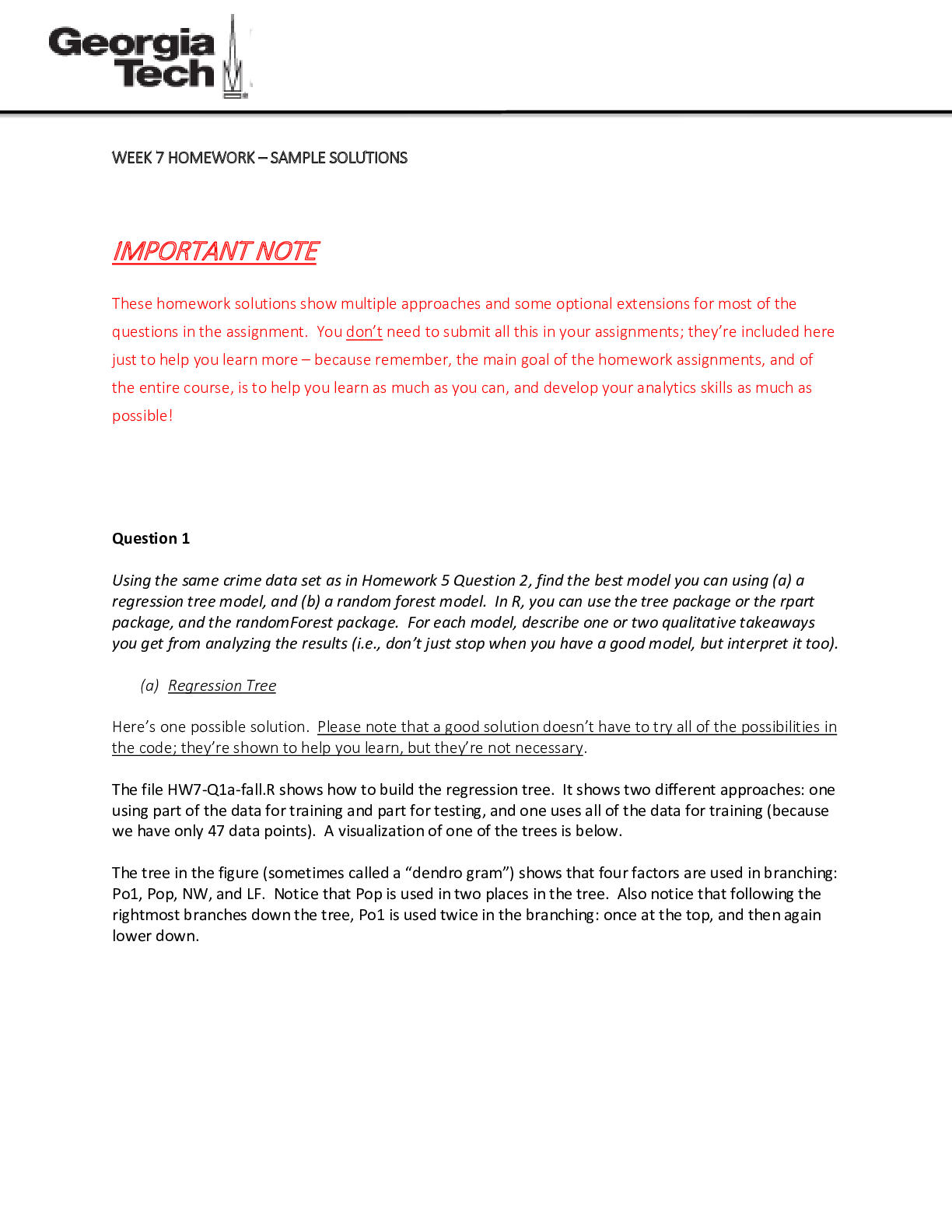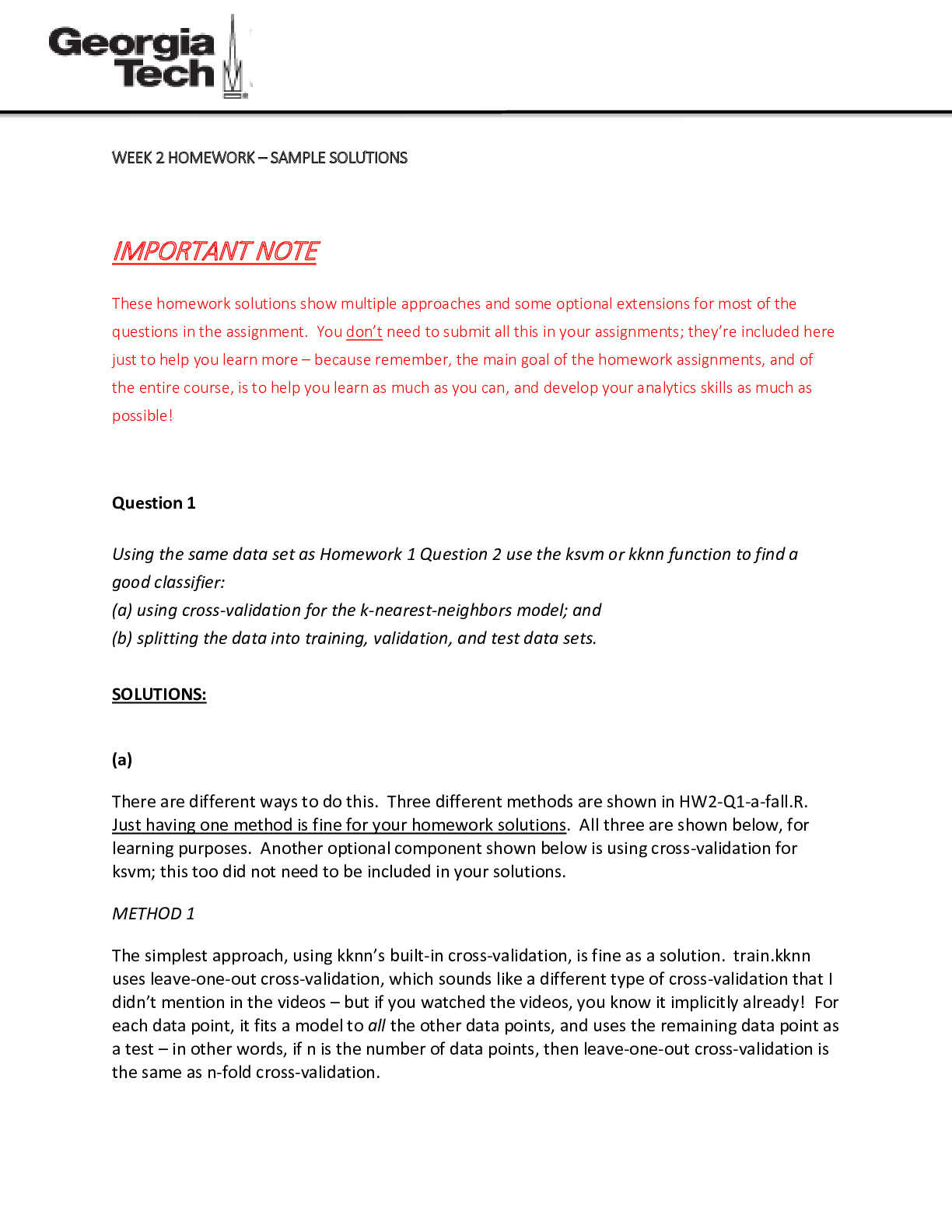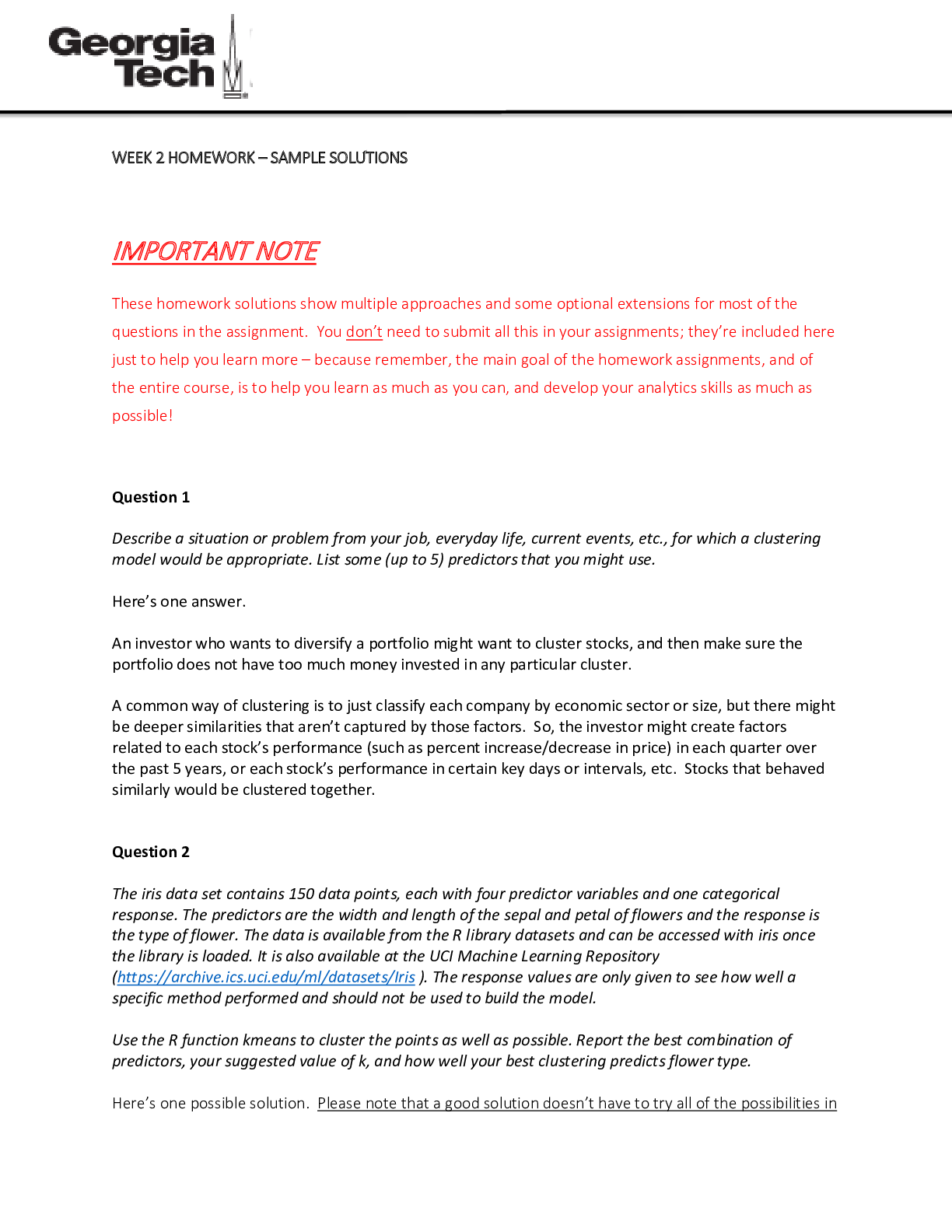Information Technology > QUESTIONS & ANSWERS > HOMEWORK 9 – SAMPLE SOLUTIONS IMPORTANT NOTE (All)
HOMEWORK 9 – SAMPLE SOLUTIONS IMPORTANT NOTE
Document Content and Description Below
HOMEWORK 9 – SAMPLE SOLUTIONS IMPORTANT NOTE These homework solutions show multiple approaches and some optional extensions for most of the questions in the assignment. You don’t need to submit... all this in your assignments; they’re included here just to help you learn more – because remember, the main goal of the homework assignments, and of the entire course, is to help you learn as much as you can, and develop your analytics skills as much as possible! Question 12.1 Describe a situation or problem from your job, everyday life, current events, etc., for which a design of experiments approach would be appropriate. Here’s one possible situation. Restaurants (the high-level expensive ones I don’t often go to) often prefer the same sort of simplicity as we sometimes do in modeling: they prefer to have a small number of items on the menu. So, a restauranteur needs to decide what combinations of entrees, side dishes, etc. to put on the menu. Of course, there are too many combinations to try them all, so a design-ofexperiments approach could help the restauranteur collect some data and make informed menu decisions. Question 12.2 To determine the value of 10 different yes/no features to the market value of a house (large yard, solar roof, etc.), a real estate agent plans to survey 50 potential buyers, showing a fictitious house with different combinations of features. To reduce the survey size, the agent wants to show just 16 fictitious houses. Use R’s FrF2 function (in the FrF2 package) to find a fractional factorial design for this experiment: what set of features should each of the 16 fictitious houses have? Note: the output of FrF2 is “1” (include) or “-1” (don’t include) for each feature. Here’s one possible solution. The file solution 12.2.R shows how to find a fractional factorial design using the FrF2 function in R. The design is shown in the table below. Features House number A B C D E F G H J K 1 -1 1 -1 -1 -1 1 -1 1 1 -1 2 -1 -1 1 1 1 -1 -1 -1 -1 1 3 1 -1 -1 1 -1 -1 1 1 1 1 4 -1 1 -1 1 -1 1 -1 -1 -1 1 5 1 -1 -1 -1 -1 -1 1 -1 -1 -1 6 1 1 1 -1 1 1 1 -1 -1 -17 -1 -1 1 -1 1 -1 -1 1 1 -1 8 -1 1 1 1 -1 -1 1 -1 1 -1 9 1 -1 1 -1 -1 1 -1 -1 1 1 10 -1 -1 -1 1 1 1 1 -1 1 -1 11 1 1 -1 -1 1 -1 -1 -1 1 1 12 1 1 1 1 1 1 1 1 1 1 13 -1 1 1 -1 -1 -1 1 1 -1 1 14 -1 -1 -1 -1 1 1 1 1 -1 1 15 1 -1 1 1 -1 1 -1 1 -1 -1 16 1 1 -1 1 1 -1 -1 1 -1 -1 Note that due to differences in the random number generator, you might get slightly different results. On a different machine, here’s another solution I got: Features House number A B C D E F G H J K 1 -1 -1 1 -1 1 -1 -1 1 1 -1 2 1 -1 1 -1 -1 1 -1 -1 1 1 3 -1 -1 -1 1 1 1 1 -1 1 -1 4 1 1 -1 1 1 -1 -1 1 -1 -1 5 -1 1 -1 -1 -1 1 -1 1 1 -1 6 1 -1 -1 1 -1 -1 1 1 1 1 7 -1 1 -1 1 -1 1 -1 -1 -1 1 8 -1 1 1 1 -1 -1 1 -1 1 -1 9 1 -1 1 1 -1 1 -1 1 -1 -1 10 -1 -1 -1 -1 1 1 1 1 -1 1 11 1 -1 -1 -1 -1 -1 1 -1 -1 -1 12 -1 1 1 -1 -1 -1 1 1 -1 1 13 -1 -1 1 1 1 -1 -1 -1 -1 1 14 1 1 1 -1 1 1 1 -1 -1 -1 15 1 1 -1 -1 1 -1 -1 -1 1 1 16 1 1 1 1 1 1 1 1 1 1 Question 13.1 For each of the following distributions, give an example of data that you would expect to follow this distribution (besides the examples already discussed in class). a. BinomialIn a clinical trial, a new drug or treatment to cure a disease is tested on a bunch of patients. Out of n total patients, the number successfully cured by the drug/treatment might follow the binomial distribution. b. Geometric A consultant flies from New York to Atlanta early every Monday morning, arriving at 9am for a 10:30am weekly meeting. The number of weeks the consultant will be on time before the first time the flight is delayed long enough to miss the meeting, might follow the geometric distribution. c. Poisson The expected number of babies that will be born in the United States tomorrow might follow the Poisson distribution. d. Exponential The time between births of babies in the United States tomorrow might follow the Exponential distribution. e. Weibull In training for track events, the length of time an athlete runs before having to stop might follow the Weibull distribution. We would expect that k < 1: weaker athletes would last a shorter amount of time, and stronger ones would last longer. Question 13.2 In this problem, you can simulate a simplified airport security system at a busy airport. Passengers arrive according to a Poisson distribution with λ1 = 5 per minute (i.e., mean interarrival rate 1 = 0.2 minutes) to the ID/boarding-pass check queue, where there are several servers who each have exponential service time with mean rate 2 = 0.75 minutes. [Hint: model them as one block that has more than one resource.] After that, the passengers are assigned to the shortest of the several personal-check queues, where they go through the personal scanner (time is uniformly distributed between 0.5 minutes and 1 minute). Use the Arena software (PC users) or Python with SimPy (PC or Mac users) to build a simulation of the system, and then vary the number of ID/boarding-pass checkers and personal-check queues to determine how many are needed to keep average wait times below 15 minutes. [If you’re using SimPy, or if you have access to a non-student version of Arena, you can use λ1 = 50 to simulate a busier airport.] Here’s one possible solution. Please note that a good solution doesn’t have to try all of the possibilities in the code; they’re shown to help you learn, but they’re not necessary.These solutions show both an ARENA model and a SimPy model; I suggest you look at both, just to get familiar with the two of them. ARENA VERSION The file solution 13.2.doe contains the ARENA model for this problem. In the picture below: (1) A “Create” block is used to model passenger arrivals to the system; they’re created as entities that will go through the security system. (2) From the passenger arrival block, they go to the ID and boarding pass check – because it’s a queue, it’s a “Process” block. The line above the block is the queue where passengers wait until it’s their turn if it’s animated. (3) After the ID and boarding pass check, passengers go to the rhombus-shaped “Decide” block, where they identify the scanner with the shortest queue, and go there. (4) The four scanner “Process” blocks are queues, like the ID and boarding pass check. (5) After finishing at a scanner, passengers leave the system. That’s a “Dispose” block; it tells the system that it can dispose of the entity so it doesn’t need to track it anymore. (That’s especially important if you have the student or trial version of Arena that can only handle 150 entities at a time.) [Show More]
Last updated: 1 year ago
Preview 1 out of 11 pages
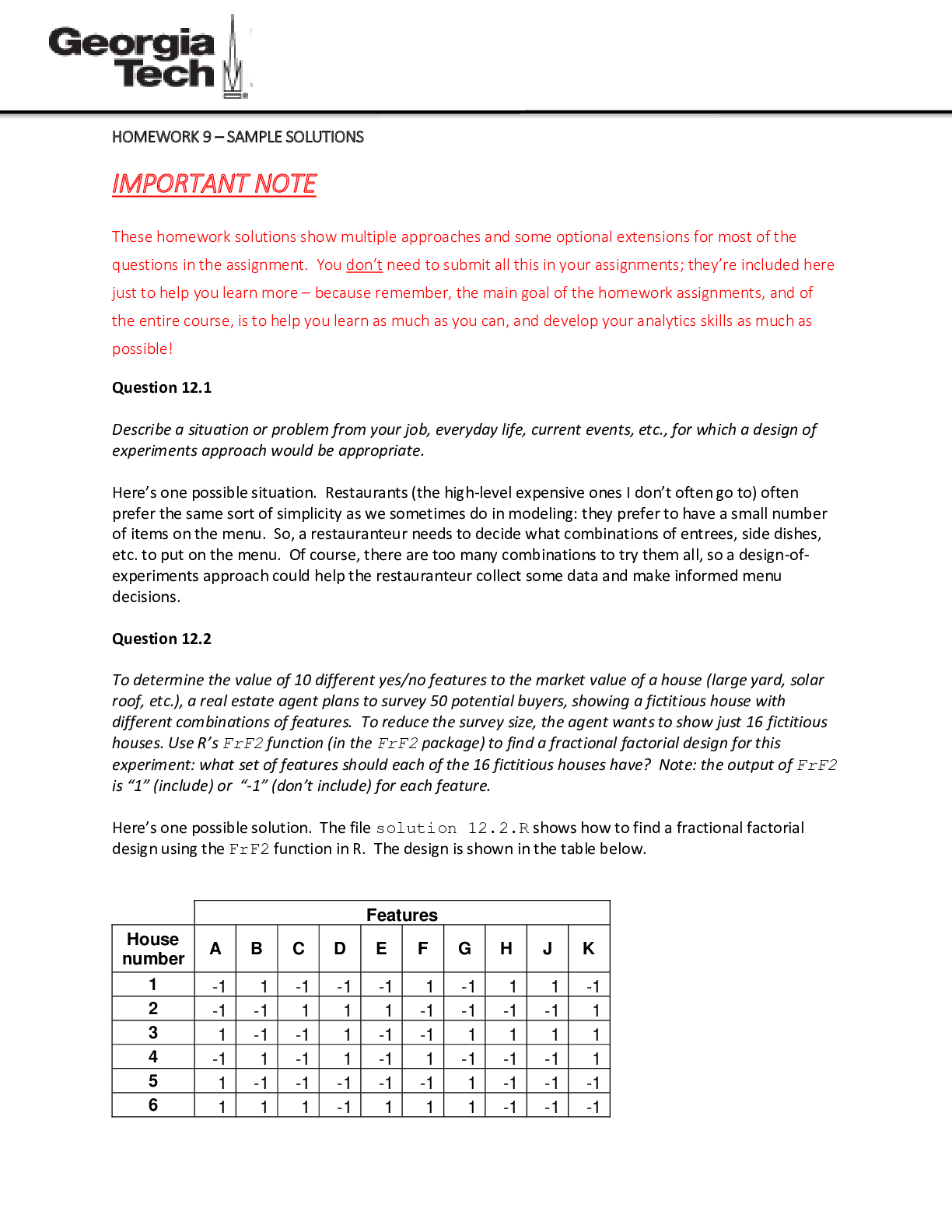
Buy this document to get the full access instantly
Instant Download Access after purchase
Add to cartInstant download
We Accept:

Reviews( 0 )
$5.00
Document information
Connected school, study & course
About the document
Uploaded On
Sep 03, 2022
Number of pages
11
Written in
Additional information
This document has been written for:
Uploaded
Sep 03, 2022
Downloads
0
Views
126
